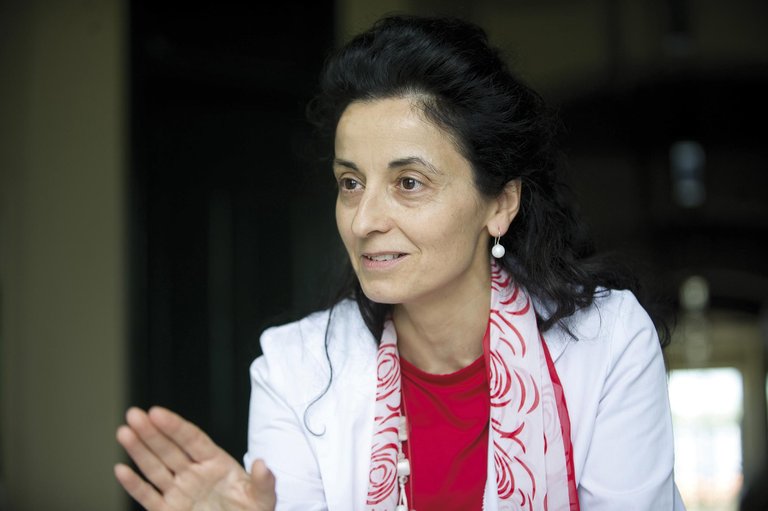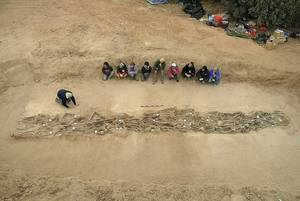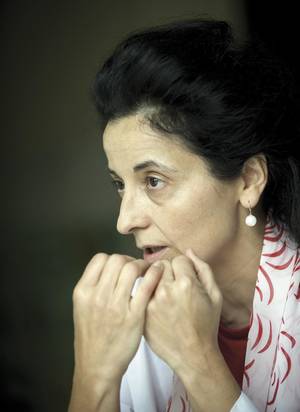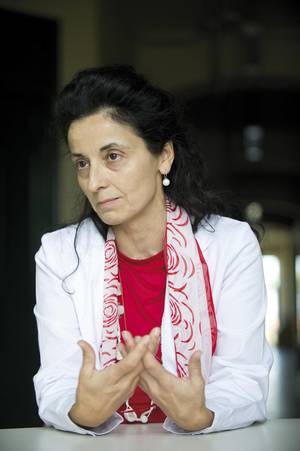"It is not the same to find naked bones as clothes: clothes bring us closer"

I think everyone has their own. Chronology, for example, is of great importance. The interest of Neolithic human remains is intrinsic, as they are found in very few deposits, so we have little chance of studying them. And other times you are interested in curiosity. Everyone has their charm.
Of course. Because you are not before bones or objects, but before people. We often surround ourselves with relatives who give us some names and surnames, tell us what was the ideology, the way of thinking, the relations that the dead relative had... It is totally different.
When you have neolithic bones, a skeleton, you are in front of an object. He has great interest in scientific research, but it is an object. Instead, in other cases, you have people ahead and it is very different. Just for clothes, it is already different...
[He has made a small pause before continuing to speak]. Finding bare bones or even clothes, you don't know the difference! Because clothing makes her a person. The skeleton is human bones and it's over. But when you have clothes you find yourself before a person. You feel close. And in those clothes there can also be objects that tell us about that person: the coin that he carries in a pocket, or the knife, or the papers! And those, help a lot in the approach.
We can distinguish between sex and age of bones and often know their pathologies. Although it had malformations it looks... These, from the morphological point of view. And then the information that the objects give us. Sometimes they tell us his craft: if he was a carpenter, he might carry a pencil; or he was a seamstress, and we found needles. Suppose it is the tomb of a king: surely we will have many objects that indicate it. Therefore, objects are of great help in completing the story.
Yes, yes. In Christianity, the dead were always buried face up. Therefore, if one is ready it means that he was condemned. They were also buried outside the cemetery. If not, they buried themselves in the cemetery and upside down, and sometimes with arms leaning on the chest or on the belly... In the deposits of the civil war, in many cases, the bodies were thrown into the hole. Then they appear in any way, with arms and legs extended, with bones broken, one over another...
If not, according to the rite, the attitude changes. We have been touched little Muslims, but they bury the alboka and always face looking at Mecca. In the Neolithic era the body was placed to one side and with arms and legs wrapped, shrunk.
And we found some mummy, for example, one we found in Arrasate, the XVI. subordinate. They are not usually intentionally mummified, but automized by weather conditions.
Many times yes. For example, if they were shot dead, they would normally get shot in the head, because it is the most effective way to kill someone. For we can see where the bullet came in and where it came out, and deduce from there how they shot it.
In some cases it was a shot in the body. There are cases that survived after the shooting. We can also see it. As a curiosity we have found two very similar examples, from very different times. One of them is from the Neolithic, with an arrow point between the cube and the radius, and it looks great that the bone continued to grow to surround the tip. The other is from the Civil War and the same thing happened to him: a piece of a projectile was left in the bone, but he did not die then and we can see that the bone wrapped the projectile. In both cases the same happened, but between one and the other there are about 5,000 years.
On the other hand, although occasionally we find bullets in the pits, it is not usual. For example, in Burgos, La Andaya, the bullets were on the side of the moat. That is, they shot in one place and then took the corpses and expelled them.
Yes. The grave is located in Lerma, where there are 29 bodies. All had political positions: Deputy of Burgos, Mayor of Aranda de Duero and councilors. One is identified by a gold ring. On a finger of the right hand, when we removed him, we saw that he had written the name of a woman inside, Benita, and a wedding date. With this we could know who it was: Tomás Requejo Requejo, deputy of Burgos.
That is. Sometimes an object gives you the trace and sometimes perhaps genetic analysis. But don't think genetic testing gives all the answers. DNA may be very damaged and cannot be analyzed. Or have DNA, but do not have adequate relatives to make comparisons. We don't always get everything we want to know, that's right.
Archaeologists; anthropologists, usually forensic anthropologists; biologists; genetics; historians... According to the case, we are also joined by sociologists and psychologists...
Everyone has their tools and their point of view, and the goal is to complete the story among all.
Depending on the time and the specific case, one or the other will be appropriate. With Neolithic remains, objects and especially dating are very important. If it is radiocarbon, better, because it allows us to determine the time to which it belongs, and in these cases it is one of the aspects that interests us most.
With the remains of the Civil War, the most important thing is identification. And for this, genetics is fundamental. Therefore, we select the techniques according to the time and what we want to know.
In fact, it happens in each case. For example, fabrics. We rarely have well-kept cloths, but if we find them in a sarcophagus, in this case the restorer specialized in fabrics will have special importance.
First, document what we want to find, doing previous surveys, surveys...
In Civil War cases, family members or associations usually ask for an investigation and tell us everything they know: where the moat is or where it was buried... So, we go there, with them, and we do an archaeological excavation and an anthropological study in situ, because we observe many things on the ground: in what position are the bodies, what objects are there and who each one is, how they are...
We also make a sketch, a drawing to place all things and take pictures. Because we know that when we dig a deposit it disappears. Therefore, it is absolutely essential to be documented.
Then we took things to the lab. And there begins laboratory work, both with bones and objects. With the bones we distinguish between sex and age, we study them anthropologically...
Normally not, but it is possible. For example, toxicological analysis is performed in cases of suspected poisoning.
On the other hand, when the bone is altered, due to the presence of chemicals in the environment, it is also possible to perform chemical analyses.
In them the archaeological excavation is of vital importance and requires time. And then come laboratory studies, as in other occasions.
Yes. We found five skeletons and expected everyone to be in a pit of 1813. But no, we have found them buried one by one and, then, surely, they are English, come to help the liberals in the first Carlist War and dead in the fight against the Carlists.
But we are not sure, because we have not found anything to know if they are from 1813 or if they are from the Carlist War. We have only found projectiles and the XVIII. From the 19th century to the mid-19th century, the shells were the same, they did not change. Therefore, they do not serve us to know who they are and when.
The question is that if they were from 1813, they might be French. We do not know, we will continue to investigate.
We continue with the sinks of the Civil War and shortly we go to Soria. Let's get ten people out. They are in four graves, which we have found, but we have not yet excavated it, we have surrounded it and prepared it alone. The other six are in another grave. Some were from the CNT and others were citizens.
All. In fact, as a whole, only 5% are women. But there are graves that only women have: Grazaleman, in Cadiz; Guillena, in Seville; and Espinosa de los Monteros, north of Burgos. There we studied a male grave and 200 meters female.
There are very few women, the repression was different against women.
In short, we will work to show how violence manifests from the Neolithic to the present. There are numerous sites around us that show violence. That is, the skeletons present evident signs of violence and through them their evolution is analyzed over time: how they were killed, what weapons they used...
And that has long been special cases. For example, in Alava, in the neo-Eneolithic site of San Juan before Portam Latinam, we find 300 people, 13 of them with arrowheads nailed to the bones. Take out the arrows that they threw into their bones. It is one of the few cases in Europe, a very important site. From there, and later, we have many interesting cases.
Buletina
Bidali zure helbide elektronikoa eta jaso asteroko buletina zure sarrera-ontzian














